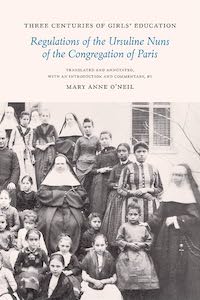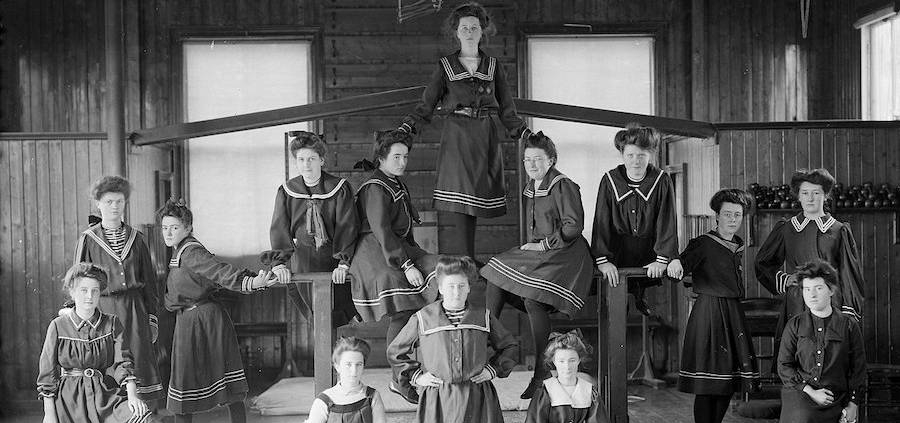Schools of Holiness by Kathryn Sadakierski

Three Centuries of Girls’ Education:
Regulations of the Ursuline Nuns
of the Congregation of Paris
By Mary Anne O’Neil
LSU Press, 2022
$30 (paperback) 171 pp.
So many of us serving in the field of education describe teaching as a vocation. For the Ursuline nuns, it quite literally is. As Mary Anne O’Neil observes in her new two-part work, Three Centuries of Girls’ Education: Regulations of the Ursuline Nuns of the Congregation of Paris, the Ursulines take teaching vows in addition to traditional vows of poverty, chastity, and obedience. Serving as educators is how the Ursuline sisters serve Christ, honoring the original vision of their foundress, St. Angela Merici, who believed each sister should not only serve as a teacher to her students, but as a spiritual mother. Herself a pioneering woman of faith, St. Angela Merici was not formally educated, but shared the knowledge she gained from being catechized at home to empower everyone in her community.
“Where your treasure is, there also will your heart be,” St. Matthew tells us. The “Regulations of the Ursuline Nuns” reflect the extent to which these religious sisters value education as a channel of salvation, a means not only for them to live out their vocation and to embody the charism of their order, but also to lead young souls to eternal splendor. Ably providing context for readers, O’Neil describes the historical landscape shaping the Regulations, giving an appreciation for the legacy of the teaching order in light of its origins (three centuries of girls’ education is nothing to sneeze at!).
Welcoming both day students and boarders, who would live at the Ursulines’ Paris convent under the supervision of the nuns, it was understood, per the Regulations, that “At all times, the Class Mistresses will show the same respect and affection to all pupils, without regard to a pupil’s condition.” Universalizing education amidst social stratification and upheaval in Revolution-era France, the Ursuline sisters made instruction accessible to female students of all class backgrounds. The indefatigable spirit of the Ursulines would live on, honoring their founding sisters who, unbroken by the destruction of the French Reign of Terror, would extend their teaching talents further afield to the United States.

Mary Anne O’Neil
Translated from the original French, the Regulations presented in O’Neil’s volume are those from 1705, though an updated, less stringent version from 1860 is also discussed in O’Neil’s preceding analysis. The Regulations include guidelines for both the sisters and their students, which come to mirror each other harmoniously. This demonstrates the inherent spirit of humility in the order, as teachers and students learn from each other. Thoughtfully engaging with and elucidating the historical document, O’Neil writes her commentary (the first part of the volume) with evident respect for the Ursulines, who educated her as a young student in the 1950s. While a scholarly text, the volume is never so esoteric as to isolate non-specialists, instead being written in a readable style that the Ursulines, who believed in accessibility, would surely approve of. Helpful footnotes throughout the volume expand upon information, which is also made more accessible through an index.
Herself a teacher, O’Neil serves as a living testament to the excellence of Ursuline instruction, offering a clear, concise, and fascinating view into the richness of church life and modes of education flowing from it. Commending the individualized, attentive instruction of the Ursulines, whose lessons she had deeply absorbed, O’Neil recalls:
It was only once I started teaching and faced the difficulty of devoting equal attention to all of my students that I began to appreciate how well my Ursuline teachers had accomplished this task. My elementary school classes were big, at least thirty girls per class, and yet the nuns knew every one of us.
The level of academic content retention among past Ursuline students like O’Neil is the result of the level of thought, care, and love the Ursulines put into their teaching. Organized meticulously, the Regulations are evidence of the Ursuline sisters’ dedication to maintaining structure and efficiency, an outgrowth of their commitment to fulfilling their vows of obedience and managing their time prudently so as to maximize opportunities for glorifying God. It is said that piety is the order of the soul. In this sense, the sisters were servants of God, personifying the Holy Spirit’s gift of piety and creating an orderly external environment so as to bring inward peace.
Following a set schedule, the Ursulines implemented what we would now call a “whole child” learning model, which promotes development across all domains, with the intention of helping students to live a fulfilling life supporting the health of mind, body, and spirit. Each teacher was dedicated to creating optimal learning conditions. The students’ daily schedule was oriented around the Ursulines’ prayer life in accordance with the liturgy of the hours, encouraging full, active participation in sacred tradition. Boarding students woke in time for morning prayers, before beginning a day that would consist of four to five hours of instruction, recess, time for recreation or reflection, and nourishing meals. As they were read stories from the lives of the saints while eating lunch, students were fed in body and soul, learning to imitate the virtues of women saints who, as O’Neil writes, “showed us how independent and strong we could become if we had the courage to follow their example.” If they could see it, they could be it.
Lest the regulations be perceived as rigid, however, it is critical to note that the nuns espoused an adaptive mindset, allowing for flexibility in customizing instruction to the diverse learning needs of students. In times of increased enrollment, classes were divided into smaller groups, keeping the student-teacher ratio small to allow for a high-quality education rooted in personal instruction. Just as Our Lord is personal, knowing how to reach us according to our needs, the Ursulines sought to course-correct according to the pace of students’ learning, reviewing material often to ensure that students understood. Beyond memorizing information, students learned to apply their learning by using their knowledge of the catechism to augment their devotional practice, and therefore their relationship with God.
♦ ♦ ♦
As an undergraduate studying education, I found that much class discussion was devoted to what constitutes a truly effective curriculum, one that transcends rote learning, allowing for achievement of higher-order critical thinking skills and their application. The overarching question was often how to fulfill learning standards and measure progress without simply transitioning from task to task, losing the savor of the learning process. A cursory glance at many learning standards reveals an emphasis on mastery of academic content, especially within set time frames. Where is there a moment to linger, to wonder, pausing with awe for what God has rendered beautiful and undying in this post-Edenic world of ours?
We consulted many international educational models as we considered the kind of approaches we would use to design and implement curricula. It was the Scandinavian countries’ educational standards that captured my imagination. Therein, the primary objective was stated, one that would certainly make Marie Kondo smile: to spark joy. Remembering the source of our joy, the One who has redeemed us and made it possible for happiness to bloom always with him in paradise, all other lessons come into perspective.
To the Ursulines, successful teaching meant instilling a sense of integrity, building character, and forming a lasting faith. Eternity was kept in view, as the sisters eschewed formal written assessment and the assignment of letter grades that would only reflect a student’s ability at one time. Envisioning students’ future potential, the sisters emphasized attainment of skills, repeating tasks until they were mastered. Girls were taught to speak “calmly” and “clearly,” to take time to express themselves eloquently when answering questions. It was not expected that first communion would be made by every girl in the second grade, but rather when the student was fully prepared and could truly cherish the goodness of receiving Christ.
Older students who demonstrated their mastery helped to teach younger students. In so doing, they were prepared to be spiritual mothers themselves, to guide others into the fold by understanding what it means to truly be a person of God, gaining awareness of their dignity so as to joyfully embrace their identity in Christ. In the view of the Ursulines, students demonstrated that they retained the catechetical lessons they learned when they lived them out, not simply when they answered verbal questions correctly. This philosophy is nowhere more apparent than in the section of the Regulations that affirms that “responsibility consists above all in teaching the girls to turn fully to God and to offer themselves to Him with all their heart.”
Here, then, is what it means to empower a girl to become an enlightened woman spiritually freed from societal constraints: one who chooses to follow God’s plan, to lift up the mind in prayer, and lift the heart in serving him with the talents they were given, accepting the will of the Creator instead of conforming to the world. In this sense, the student would become the teacher, mirroring her Ursuline instructors who bravely accepted God’s invitation to live out their vocation regardless of dangers in the face of religious persecution and other adversities.

Lithograph of Ursuline Convent, 9th Ward of New Orleans, 1880s
In this and in many other ways, the Regulations were ahead of their time. They were developed at a period when women had limited opportunity for education and professional advancement. Seeking to impart the holy wisdom of God to students in such a way that would deeply impact their hearts, the Ursuline sisters took time to develop themselves spiritually so as to better form the souls of young women, future evangelizers in the same tradition of the women of the Bible Jesus chose to share the Good News. From the Samaritan woman at the well to Mary Magdalene telling of the Resurrection, all were witnesses to Christ, image-bearers transformed by God. Seeing their students as God’s creation ultimately informed the practices of the Ursulines.
The Ursulines’ perception of education was not a one-way dissemination of information, but a form of mutual exchange. In responding to the Regulations, in following them, as it were, the nuns demonstrated their own receptivity to receiving inspiration, to learning and becoming better educators. As the Regulations state, “they should give themselves over to their work with great affection and a heart filled with charity and zeal, trying to form themselves in the true spirit of the Ursuline order, which is so well expressed in the first part of the Ursuline constitution. To this end, they should read the constitution often.” “Mission drift,” in this sense, could be avoided, with the Ursulines remaining focused on their core purpose.
Catechism was the largest part of the integrated curriculum, which also included arithmetic, reading, spelling, and writing, subjects used as a means to further theological knowledge. Before teaching catechism, the Ursulines were expected to pray to the Holy Spirit for “grace and enlightenment,” humbly recognizing that each person achieves their potential through God’s grace. When it came to the Ursuline curriculum, the center held because all teachings pointed back to Christ—much like how the medieval mind saw the Eucharist as the center of a wheel, with the sacraments like spokes issuing from it.
At the heart of the Ursulines’ pedagogical practice was bringing students closer to the hearts of Jesus and Mary, thereby fortifying them to bring the love of God out into the world, fulfilling the unique vocation given to them by God. Teaching was not meant to distract the sisters from their interior lives. Instead, guiding the education of young women encouraged the flourishing of virtues in the sisters, with the action of teaching deepening contemplation. Engaging faith, as the Ursulines understood, did not mean suspending disbelief. The Ursulines engaged reason to engage faith; they equipped girls with the spiritual tools they needed to use their free will to follow Christ, helping them to know him so that they could better love him, being fulfilled from their access to centuries of Catholic wisdom. The classroom of the convent school, then, became its own kind of chapel, a place for girls to discover their own callings.
Reading through the objectives enumerated in the Regulations, it is clear that young women were taught to lead through the example of Mother Mary. (The growing sanctity of students was honored, with a student’s good behavior even meriting a “crowning” with flowers, making them like a little Mary being coronated.) More than a symbol of submission, the Blessed Mother is a model of every gift of the Holy Spirit, notably fortitude, wisdom, and hope amidst suffering. So, too, were girls taught by the Ursulines to look with love at all things. Charity was the utmost virtue the girls were called to emulate, it being stated in the Regulations that they should call their classmates “Sister” or “Friend.” In class guilds dedicated to special spiritual devotions or saints, the young women led each other, reaching higher levels of membership and supporting each other in their faith journeys at a time when most equivalent faith-based social organizations were exclusive to men.
♦ ♦ ♦
In the first part of the book, O’Neil offers brief asides about post–Vatican II changes in organization and governance within the Ursuline order, but largely maintains a focus on past practices of the Ursulines. Her research leads her to primary sources beyond the Regulations themselves, including correspondences between Ursuline sisters, that shed light on their pedagogical approach. Sharing childhood memories of her own Ursuline educational experiences, she reflects that “My inability to let go of my subject was the result in part of stepping onto the campus of Ursuline Academy after more than a sixty-year absence. I was struck by how little the grounds and the school buildings had changed since my time there.”
As a woman for whom education has been life-changing, the Regulations are personally resonant for me, too. Having been educated at a Catholic high school and, subsequently, a women’s university, my passion for both Catholic and women’s education stems from my belief in God’s love for us, a love that begs to be shared, to be given so that hearts would be changed. In my work with students, I have striven to honor Christ in each child, to inspire them to use their God-given gifts to change the world with love, like Jesus. To expand the reach of O’Neil’s narrative, I would have liked to have seen more in the vein of personal reflection and contemporary connections to the translated text, especially through interviews with current staff or students at Ursuline schools, to provide insight into how the traditional Ursuline regulations are upheld today.
In carefully translating the Regulations of the Ursuline sisters, O’Neil has made available a treasure chest of wisdom that provides a roadmap for us all to spark joy, to open our hearts to learning from every experience, every person, revealing something about Christ to us. In much the same manner as St. Therese of Lisieux and her Little Way, we can draw spiritual meaning from even the most seemingly mundane tasks, all of which the Ursulines see as worthy of being taught—no doubt because they allow for sanctification, for greater understanding, to be gained. O’Neil’s translation is an enlightening reference, a reflective tool for seasoned Catholic educators, ministry professionals serving in the area of faith formation, and all readers intrigued by the intersections between education, theology, and culture. There is fresh detail about the church’s past that illuminates its present, demonstrating how much eternal beauty is to always be found there, like light falling on stained glass, drawing the eye to a previously unseen element of an otherwise familiar scene.
We see both the spiritual and corporeal works of mercy when we read of the Ursulines caring for students by helping them to arrange their hair, but also to organize their thoughts cohesively in written expression. Whether correcting penmanship or stitches, leading girls through the process of examining their consciences or blessing themselves, the Ursulines were forever “guiding the pupil’s hand,” treating students with respect so that they might show the same to others, in the spirit of Jesus and Mary. Everywhere, we see opportunities to heal, to begin again, to always recommence the learning process. The behaviors the Ursuline sisters outline in their Regulations do not serve merely as quaint remembrances of a bygone era for contemporary readers to digest; rather, they call us to reflect on how we continue to orient ourselves in the dance of the church year, how we follow its rhythms and take steps to outwardly manifest our own love for Christ, making him visible to the people we meet. This is the salvific aspect of education, the soul of hope that seeks to keep the light of curiosity burning in each student, all of us eternal students seeking God, our teacher showing us the way.
Having developed an original catechetical curriculum in my work as a director of religious education, I greatly respect the work of the Ursulines, the depth of their knowledge and devotion, their professionalism as educators, as well as their incredible love as Catholic spiritual mothers nurturing children. Reading the Regulations, it is easy to sense the hands of God, working through the Ursulines, still guiding. He whispers into the heart, urging us, as a community unified in him, to preserve the traditions so lovingly celebrated by the Ursulines by sharing them with future generations. We’re extended God’s invitation to be in communion with him, with our family in the church, so that we might gracefully join her procession through the ages, weaving our voices into the hymns of adoration. ♦
Kathryn Sadakierski’s writing has appeared in Agape Review, DoveTales, Edge of Faith, Ekstasis Magazine, enLIVEN Devotionals, Refresh Bible Study Magazine, and elsewhere. She holds a B.A. and M.S. from Bay Path University. Kathryn is passionate about sharing her love for God through her work, with the goal of making a positive impact.





Leave a Reply
Want to join the discussion?Feel free to contribute!